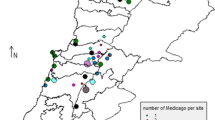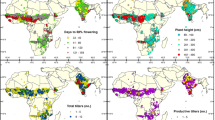Abstract
Proso millet (Panicum miliaceum L.) is one of the oldest cereal grains cultivated in the north-western part of Nepal. Not a single proso millet variety has been released so far for cultivation in Nepal. To assess the genetic diversity of proso millet conserved in the National Agriculture Genetic Resources Centre, 42 accessions of proso millet were characterized in Khumaltar (1360 m a.s.l.), Lalitpur in 2015 that were collected from the Humla (1900–2800 m a.s.l.) and Jumla (2300–2600 m a.s.l.) districts of the Western Himalayas of Nepal. Seven quantitative and nine qualitative traits were recorded using standard descriptors. The accessions were found to be diverse using Shannon–Weaver diversity indices (H′) for the quantitative traits of days to heading and maturity, plant height, panicle length, panicle exertion, flag leaf length and grain yield, whereas low diversity was observed for the qualitative traits of leaf sheath colour, flag leaf angle, grain shape, and grain colour, and no diversity was observed for leaf pubescence. The accessions were grouped in five clusters where an accession in Cluster-5 and six accessions in Cluster-4, all from Humla, were found to be high-yielding, early-maturing and of taller plant height. In contrast, 4 accessions in Cluster-2 (3 from Jumla) were low-yielding, late-maturing and of shorter plant height. Accessions H237, H176, H311, H489, H490, H643 and H653, all from the Humla district, performed better in the preliminary evaluation. Although these accessions could be used for future breeding to develop climate-resilient varieties, the genebank could employ an innovative method of using participatory diversity kits to promote farmer selection for immediate benefits.




Similar content being viewed by others
Notes
The Integrating Traditional Crop Genetic Diversity for Mountain Food Security project focuses on the important, nutritious, and climate-resilient crops in the high mountain agricultural ecosystems in Nepal from the perspective of breeding, processing, promotion, and policies. (www.himalayancrops.org).
References
Dong YC, Zheng DS (2006) Crops and their wild relatives in China. China Agriculture Press, Beijing, pp 331–359
Gordon TL, Raizada MN (2015) Genetic diversity and genomic resources available for the small millet crops to accelerate a New Green Revolution. Front Plant Sci, 24 March 2015. http://doi.org/10.3389/fpl.2015.00157 (http://doi.org/10.3389/fpl.2015.00157)
Habiyaremye C, Matanguihan JB, Guedes JD, Ganjyal GM, Whiteman MR, Kidwell KK, Murphy KM (2017) Proso millet (Panicum miliaceum L.) and its potential for cultivation in the Pacific Northwest, US: a review. Front Plant Sci 7:1–17. doi:10.3389//fpls.2016.01961
Hodgkin T, Ramanatha Rao V, Cibrian-Jaramillo A, Gaiji S (2003) The use of ex situ conserved plant genetic resources. Plant Genet Res 1(1):19–29. doi:10.1079/PGR200313
IBPGR (1985) Descriptors for Panicum miliaceum and P. sumatrense. International Board for Plant Genetic Resources, Rome, p 14
Jana K, Jan M (2006) Content and quality of protein in proso millet (Panicum miliaceum L.) varieties. Plant Foods Hum Nutr 61:45–49
Joshi KD, Subedi M, Rana RB, Kadayat KB, Sthapit BR (1997) Enhancing on-farm varietal selection: a case study for Chaite rice in Nepal. Exp Agric 33:335–344
Lagler R, Gyulai G, Humphreys M, Szabo Z, Horvath L, Bittsanszky A, Kiss J, Holly L, Heszky L (2005) Morphological and molecular analysis of common millet (P. miliaceum) cultivars compared to a DNA sample from the 15th century (Hungary). Euphytica 146:77–85
Liu XY, Fuller DQ, Jones MK (2015) Early agriculture in China. In: Barker G, Goucher C (eds) The Cambridge world history, volume 2A world with agriculture, 12,000 BCE-500 CE. Cambridge University Press, Cambridge
Liu M, Yue X, Jihong H, Zhang S, Wang Y, Lu P (2016) Genetic diversity and population structure of broomcorn millet (Panicum miliaceum L.) cultivars and landraces in China based on microsatellite markers. Int J Mol Sci 17:370. doi:10.3390/ijms17030370
MoAD (2014) Millet mission programme: annual progress report, 2070/071. Government of Nepal, Ministry of Agriculture Development (MoAD), Department of Agriculture, Regional Agriculture Directorate, Surkhet, Nepal
Murphy PJ, Witcombe JR (1981) Variation in Himalayan barley and the concept of centres of diversity. In: Barley genetics IV. Proceedings of the IV international barley genetics symposium. Edinburgh University Press, Edinburgh, pp 26–36
Palikhey E, Sthapit SR, Gautam S, Gauchan D, Joshi BK, Sthapit BR (2017) Baseline survey report: III. Haku, Jumla, Integrating Traditional Crop Genetic Diversity into Technology: Using a Biodiversity Portfolio Approach to Buffer against Unpredictable Environmental Change in the Nepal Himalayas. Pokhara, Nepal: LI-BIRD, NARC, DOA and Bioversity International
Parajuli A, Subedi A, Sthapit SR, Gauchan D, Adhikari A, Joshi BK and Sthapit BR (2017) Baseline survey report: IV. Chhipra, Humla, Integrating Traditional Crop Genetic Diversity into Technology: Using a Biodiversity Portfolio Approach to Buffer against Unpredictable Environmental Change in the Nepal Himalayas. Pokhara, Nepal: LI-BIRD, NARC, DOA and Bioversity International
Raggi L, Ciancaleoni S, Torricelli R, Terzi V, Ceccarelli S, Negri V (2017) Evolutionary breeding for sustainable agriculture: selection and multi-environmental evaluation of barley populations and lines. Field Crop Res 204:76–88. doi:10.1016/j.fcr.2017.01.011
Reddy VG, Upadhyaya HD, Gowda CLL (2007) Morphological characterization of world’s proso millet germplasm collection. SAT eJ 3(1) www.ejournal.icrisat.org
Saha D, Gowda MVC, Arya L, Verma M, Bansal KC (2016) Genetic and genomic resources of small millets. Crit Rev Plant Sci 35:56–79. doi:10.1080/07352689.2016.1147907
Saud NB (2010) Crops of Nepal and their sustainable farming (in Nepali): Nepalka balinali ra tinko digokheti. Sajha Prakashan, Pulchok, Lalitpur, pp 223–227
Shannon CE, Weaver W (1949) The mathematical theory of communication. The University of Illinois, Chicago, pp 3–24
Stevens CJ, Murphy C, Roberts R, Lucas L, Silva F, Fuller DQ (2016) Between China and South Asia: a middle Asian corridor of crop dispersal and agricultural innovation in the Bronze Age. Holocene 26(10):1541–1555. doi:10.1177/0959683616650268
Sthapit BR, Rao VR (2009) Consolidating community’s role in local crop development by promoting farmer innovation to maximise the use of local crop diversity for the well-being of people. In: Jaenicke H, Ganry J, Höschle-Zeledon I, Kahane R (eds) Underutilized plants for food, nutrition, income and sustainable development. Proceedings of international symposium held in Arusha, Tanzania, 3–7 March 2008. Acta Horticulturae 806. International Society for Horticultural Science. Leuven, Belgium p 739
Trivedi AK, Arya L, Verma M, Verma SK, Tyagi RK, Hemantaranjan A (2015) Genetic variability in proso millet (Panicum miliaceum L.) germplasm of Central Himalayan Region based on morpho-phsyiological traits and molecular markers. Acta Physiol Plant 37:23. doi:10.1007/s11738-014-1770-y
van Etten J, Beza E, Calderer L, van Duijvendijk K, Fadda C, Fantahun B, Gebrehawaryat KY, van de Gevel J, Gupta A, Mengistu DK, Kiambi D, Mathur PN, Mercado L, Mittra S, Mollel MJ, Rosas JC, Steinke J, Suchini JG, Zimmerer KS (2017) First experiences with a novel farmer citizen science approach: crowdsourcing participatory variety selection through on-farm triadic comparisons of technologies (Tricot). Exp Agric. doi:10.1017/S0014479716000739
Witcombe JR, Khadka K, Puri RR, Khanal N, Sapkota A, Joshi KD (2016) Adoption of rice varieties–2, accelerating uptake. Expl Agric. doi:10.1017/S0014479716000624
Zhao Z (2011) New archaeobotanical data for the study of the origins of agriculture in China. Curr Anthr 52(S4):S295–S306
Acknowledgements
This paper is the output of the GEF/UNEP supported project, “Integrating Traditional Crop Genetic Diversity into Technology: Using a Biodiversity Portfolio Approach to Buffer against Unpredictable Environmental Change in the Nepal Himalayas” implemented in Nepal. The project is coordinated by Bioversity International in collaboration with Nepal Agricultural Research Council (NARC), Department of Agriculture (DoA) and Local Initiatives for Biodiversity Research and Development (LI-BIRD). The authors would like to acknowledge Dr. MN Paudel, Mr. MR Bhatta and Mr. M Bhattarai (NAGRC), Mr. Sajal Sthapit (WSU, USA), Dr Devra Jarvis, and Dr. D Gauchan (Bioversity International) for technical support and encouragement. Thanks to Julia Herrle (Bioversity–Nepal office) for language editing (Grant #A1150).
Author information
Authors and Affiliations
Corresponding author
Ethics declarations
Conflict of interest
The authors declare no conflict of interest.
Rights and permissions
About this article
Cite this article
Ghimire, K.H., Joshi, B.K., Dhakal, R. et al. Diversity in proso millet (Panicum miliaceum L.) landraces collected from Himalayan mountains of Nepal. Genet Resour Crop Evol 65, 503–512 (2018). https://doi.org/10.1007/s10722-017-0548-7
Received:
Accepted:
Published:
Issue Date:
DOI: https://doi.org/10.1007/s10722-017-0548-7




